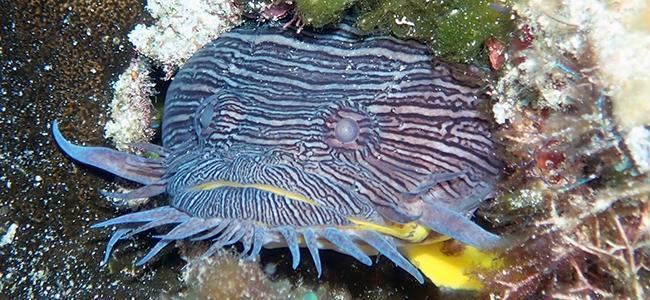Toadfishes belong to the order Batrachoidiformes, in which there are 101 described species organized in a single family (Batrachoididae) and 4 subfamilies (Porichthyinae, Thalassophryninae, Batrachoidinae, Halophryninae) in which there are 23 different genera. They are generally marine species (with some exceptions in brackish and fresh waters, which will be discussed later) that inhabit the bottom, from shallow coastal waters to deeper inland waters. They are generally relatively common species in the Atlantic, Indian and Pacific oceans.
The subfamily Thalassophryninae, is the exception within the toadfishes, finding the species belonging to this subfamily exclusively in fresh waters of South America. Also noteworthy in this subfamily is the presence of hollow spines on the dorsal fin and on the operculum, which are connected to very venomous glands. Another subfamily, Porichthyinae, is also notable for the presence on its flanks of structures specialized in producing bioluminescence, since these are species that live at greater depths where absolute darkness reigns. They use these photophores to attract prey.
As for the size of toadfishes, we can say that they are an order of not very large fishes, ranging from almost 8 cm in the case of Thlassophryne megalops, to almost 60 cm in the case of the Pacuma toadfish (Batrachoides surinamensis). As a group of species, they are characterized by a large, wide and flattened head, with eyes located in upper positions. The mouth is also usually large and often has baleen or other fleshy appendages on its edges. Behind the head, we find the operculum, in which it is common for the species to have spines. The rest of the body is usually conical in shape, and as a general rule does not usually have scales, or those species that do have them, these are very small.
Toadfishes have two dorsal fins, clearly separated from each other. The first dorsal fin is short and has 2 to 3 spines. The second dorsal fin is much longer and has up to 40 soft rays. The anal fin is also long, with up to 39 soft rays. The pectoral fins are large and wide. The pelvic fins are jugular, that is to say they are located in a fairly advanced position on the body at the vertical height of the operculum, and are formed by a spine and 3 soft rays.
As for coloration, toadfishes are usually rather dull in color, although certain reef-dwelling species can adopt more colorful colors, as is the case of the splendid toadfish endemic to the Mexican island of Cozumel (Sanopus splendidus).
They feed on invertebrates (preferably molluscs and crustaceans) and some fish by hunting on the bottom. Their cryptic coloration allows them to camouflage themselves perfectly with the bottom, to ambush their prey that usually do not notice the presence of the toadfish.
Toadfish are known for their ability to emit rhythmic sounds, particularly the males. They do this thanks to their swim bladder, in order to attract females. Males make nests to which they attract females with their songs. When the female lays her eggs, the eggs are adhesive on one side, attaching themselves to the sides of the nest. It is common for a single male to attract several females to his nest in a short period of time, and therefore the offspring born will be genetically very varied. The male will take care of the offspring from the time of laying until 4 weeks after hatching, when the young become large enough to fend for themselves.
